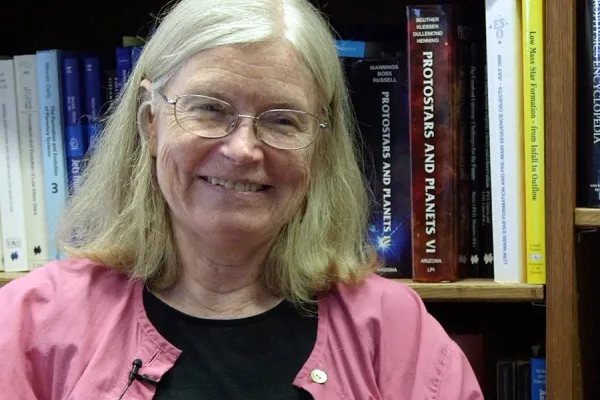The Big Eclipse
Research & Inquiry

Published August 7, 2017
Like most astronomers, Suzan Edwards is excited about the total eclipse in August and wants everyone to know why it is such a momentous event
On August 21, astronomy professor Suzan Edwards will be camping somewhere in southern Wyoming with family and friends. She chose the spot for a good reason: it will be in the path of totality, making it among the best places in the country to watch that day’s total solar eclipse—the first in a century to sweep across the entire continental United States.
“All we have to do is roll out of our tents and there it is,” says Edwards.
This isn’t the first time Edwards has been excited by the prospect of witnessing an eclipse. She has vivid memories of a March day in 1970, standing on the shore of a beach in Nantucket, watching a solar eclipse with a group of friends from Wellesley College, where she was a first-year student. She remembers jumping up and down on the beach, screaming with excitement for “maybe a minute of the eclipse,” she says.
That moment proved to be life changing. “I get tears remembering what it’s like,” she says. And it was also a moment that helped lead her on to a career in astronomy.
These days, she’s getting excited for the upcoming eclipse because so many people will get to see a bit of astronomy in action.
In her office one afternoon last month, Edwards, the L. Clarke Seelye Professor of Astronomy, explained that a total solar eclipse—where the moon completely blocks our view of the sun for a few memorable minutes—is a spectacle unlike anything most people have ever seen. Using a large white stability ball as the sun, Edwards demonstrated the scale of the moon and the sun, and how the eclipse occurs. See video, below.
This year, the moon will pass between the sun and the earth on August 21, creating a 70-mile-wide shadow that will completely block out the sun for roughly two minutes starting at 10:18 a.m. PDT in Salem, Oregon, carving a direct path toward the southeastern U.S. Some 90 minutes later, the total eclipse will be visible to residents of Charleston, South Carolina, at 2:27 p.m. EDT—who are among the last to see the celestial event.
Even those states not in the path of totality will witness a partial eclipse, according to Edwards. “It’s not the same thing. It’s not going to raise your hair on edge. It’s not going to change your life, but it’s a pretty fun phenomenon to experience.”
Edwards waxes almost poetic about what happens during a total eclipse. She compares the darkness of the sky to a “curtain of blackness sweeping across the earth, and it engulfs you.” At this point, the sun is hidden from view, but still visible will be the sun’s faint outer atmosphere—the corona—which may or may not show colors, sometimes tones of red or green light. It all depends on the magnetic storms affecting the sun at that particular moment.
“But during the minutes of totality it’s dark, dark. It’s like a black hole on the night side of the moon, with the corona shining around it,” Edwards says.
And she urges those interested in watching the eclipse to heed those warnings about not looking directly into the sun except during the few minutes when the sun is completely blocked. Get your special glasses—certified solar filters known as “solar viewers”—easily purchased online, to block 99.99 percent of the sun’s visible light and 100 percent of its ultraviolet rays.